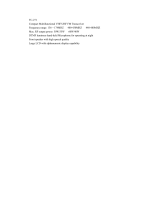
vi
CONTENTS
TNC....................................................................... 79
TRANSVERTER .................................................... 79
TX MONITOR ........................................................79
TX POWER ...........................................................79
QUICK DATA TRANSFER ..................................... 80
SETTING UP.....................................................80
Equipment Needed .......................................80
Connections ................................................. 80
USING QUICK TRANSFER............................... 80
Transferring Data.......................................... 80
Receiving Data .............................................80
COMPUTER CONTROL........................................ 81
SETTING UP.....................................................81
Equipment Needed .......................................81
Connections ................................................. 81
COMMUNICATION PARAMETERS .......................81
REMOTE MICROPHONE CONTROLLER............. 81
WIRELESS REMOTE CONTROL (K-type ONLY) .. 82
PREPARATION ................................................. 82
CONTROL OPERATION ................................... 82
SKY COMMAND II+ (K-type ONLY) .......................83
PREPARATION ................................................. 83
CONTROL OPERATION ................................... 84
USING TH-D7A AS A COMMANDER................. 85
CONTROL OPERATION ................................... 85
USING ANOTHER TS-2000
AS A COMMANDER .......................................... 87
USING A SEPARATE TRANSPORTER ............. 88
REPEATER FUNCTION (K-type ONLY)................. 88
LOCK-BAND REPEATER..................................88
CROSS-BAND REPEATER............................... 88
HANG TIME FOR REPEATER FUNCTION .......88
DRU-3A DIGITAL RECORDING UNIT
(OPTIONAL) .......................................................... 89
RECORDING MESSAGES................................ 89
MESSAGE PLAYBACK ..................................... 89
Checking Messages ..................................... 89
Sending Messages ....................................... 90
Erasing a Recorded Message ....................... 90
Changing Inter-message Interval Time.......... 90
Changing Playback Volume .......................... 90
VS-3 VOICE SYNTHESIZER (OPTIONAL)............ 91
MICROPROCESSOR RESET ............................... 92
INITIAL SETTINGS............................................ 92
PARTIAL RESET ...............................................92
FULL RESET..................................................... 92
CHAPTER 16 CONNECTING PERIPHERAL EQUIPMENT
COMPUTER.......................................................... 93
COMPATIBLE TRANSCEIVER .............................. 93
RTTY EQUIPMENT ...............................................94
HF LINEAR AMPLIFIER ........................................ 94
ANTENNA TUNER ................................................94
MCP AND TNC ......................................................95
TYPICAL MCP/ TNC SETUP ................................. 96
LINEAR AMPLIFIER (50 MHz, 144 MHz, 430
(440) MHz and 1.2 GHz) ........................................ 96
CHAPTER 14 SCAN
NORMAL SCAN .................................................... 66
VFO SCAN ........................................................66
PROGRAM SCAN .............................................67
PROGRAM SCAN PARTIALLY SLOWED.......... 67
SCAN HOLD ..................................................... 68
MHz SCAN ........................................................68
MEMORY SCAN....................................................68
SCAN RESUME METHOD ................................ 68
ALL-CHANNEL SCAN ....................................... 68
GROUP SCAN ..................................................69
CALL SCAN....................................................... 69
VISUAL SCAN ...................................................70
Using Visual Scan (VFO) .............................. 70
Changing the Number of Channels to Scan ..70
Using Visual Scan (Memory Channel)...........70
CHAPTER 15 OPERATOR CONVENIENCES
ALT (Auto Lock Tuning)..........................................72
ANTENNAS ........................................................... 72
HF/ 50 MHz BAND.............................................72
VHF/ UHF/ 1.2 GHZ BAND ................................72
APO (Auto Power OFF) .........................................72
AUTOMATIC ANTENNA TUNER ...........................72
Presetting ..........................................................73
ATTENUATOR....................................................... 73
AUTO MODE......................................................... 73
BEEP FUNCTION.................................................. 74
CALL CHANNEL....................................................75
DISPLAY ...............................................................75
BRIGHTNESS ...................................................75
CONTRAST....................................................... 75
KEY ILLUMINATION ..........................................75
DTMF ....................................................................75
MANUAL DTMF DIALING..................................75
DTMF MEMORY ...............................................75
Entering DTMF tones.................................... 75
Transmitting DTMF Memory Channel Data ... 76
DTMF Tone Time Length ..............................76
DTMF Pause Period ..................................... 76
HF RX ANTENNA .................................................. 76
LINEAR AMPLIFIER CONTROL ............................76
LOCK FUNCTIONS ...............................................77
FREQUENCY LOCK FUNCTION ......................77
LOCK ALL FUNCTION ...................................... 77
MICROPHONE PF KEYS ......................................77
MONITOR .............................................................77
PF KEY.................................................................. 77
RISE TIME OF CW................................................ 77
RX DSP EQUALIZER ............................................78
EQUALIZING RECEIVING AUDIO
(SSB/ FM/ AM)...................................................78
SEPARATE SPEAKER OUTPUT........................... 78
S-METER SQUELCH ............................................78
SQUELCH HANG TIME..................................... 78
TIME-OUT TIMER .................................................78






















